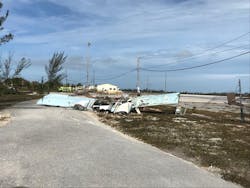Hurricane Dorian Lashes Florida and Puts Carolinas in Harm’s Way
(Bloomberg) -- Hurricane Dorian is menacing the U.S. East Coast with devastating flooding and winds, lashing Florida after laying waste to the Bahamas in a brutal two-day battering that caused damage that may cost the islands billions of dollars.
Dorian’s center was about 95 miles (145 kilometers) east of Daytona Beach, Florida, with sustained winds of about 105 miles per hour, the National Hurricane Center said in an 8 a.m. New York time advisory. Dorian is moving at 8 miles an hour parallel to the coast, and could possibly make landfall as a Category 1 storm on North Carolina’s Outer Banks on Thursday, according to Adam Douty, a meteorologist with AccuWeather Inc.
President Donald Trump has declared a state of emergency in North Carolina, clearing the way for U.S. disaster relief. Meanwhile, Florida’s shoreline is being lashed by driving rains and wind gusts, and the Bahamas are reeling from the after effects of the strongest storm to hit the islands in modern history, with seven confirmed deaths and more expected.
With the storm widening out, “coastal areas of Georgia, South Carolina and North Carolina will likely receive stronger winds than Florida,” Todd Crawford, chief meteorologist at the Weather Co., an IBM business, said in an email. “Further, given the proximity to the coast parts of coastal South Carolina may receive a foot of rain.”
In the Bahamas, the government discontinued all tropical storm warnings, according to the hurricane center advisory.
Still, Dorian has left many of the nation’s islands devastated, with the waters just starting to recede from a storm surge that hit 23 feet at times. Prime Minister Hubert Minnis at a news conference said he expects the death toll to rise. Parts of the Abaco islands have been “decimated” with “severe damage to homes, businesses and other buildings and infrastructure,” Minnis said at a press conference.
The damage wrought upon Grand Bahama and neighboring Abaco by the “monster storm” is likely to run into “hundreds of millions if not billions,” the Nassau Guardian newspaper cited Deputy Prime Minister Peter Turnquest as saying. Large tracts of homes are under water, and the government intends to make formal appeals for assistance, he said.
On Tuesday, the Bahamas government delivered an “urgent plea” for owners of boats and jet skis to help out with post-hurricane rescue operations for residents stranded by flood waters.
In the U.S., coastal regions from Georgia to southeast Virginia could face life-threatening surges and driving rain over the next 48 hours, according to the hurricane center.
Florida’s coast is expected to be hit with 3 to 6 inches of rain, with some isolated areas getting as much as 9 inches, the National Hurricane Center said. Some areas in the northeast could also see tropical storm-level wind gusts of as much as 73 mph.
There were more than 13,000 homes and businesses without power at 8:22 a.m. local time, mostly centered around the northeast coast near Jacksonville, according to utility websites.
Cities further up the coast were bracing for the storm. Sandbags have been distributed in Charleston, South Carolina, and the city encouraged some residents to park their vehicles on higher ground. Local and state governments in Florida, Georgia and the Carolinas have ordered coastline residents and businesses to begin evacuations.
“Please listen to and follow all evacuation orders,” North Carolina Governor Roy Cooper said in a statement announcing a mandatory evacuation order for the state’s tourist-friendly coast. “We have seen the life and death effects of this storm in the Bahamas, and we urge everyone on the islands at the coast to leave.”
Looking forward, the storm will sweep by Cape Cod in Massachusetts over the weekend. bringing 40 mph to 50 mph wind gusts, according to Accuweather’s Douty. “It will not be any worse than a typical nor’easter for them,” he said
